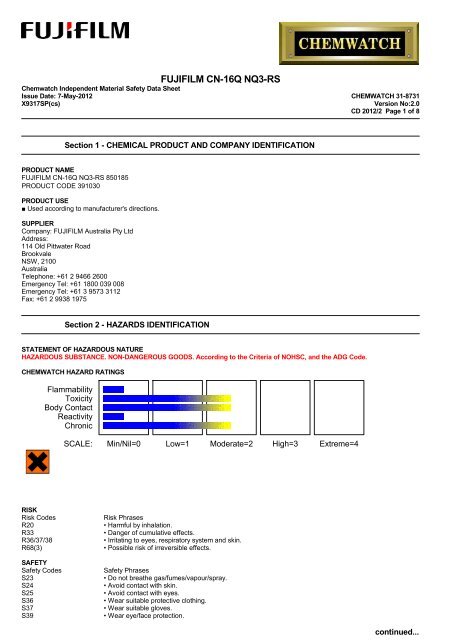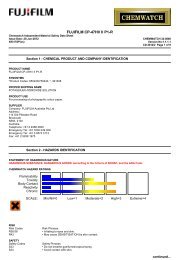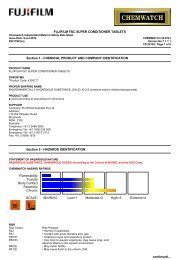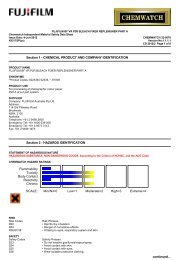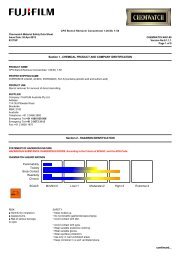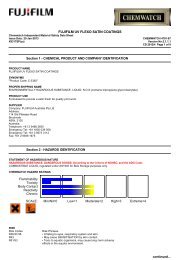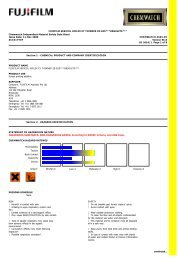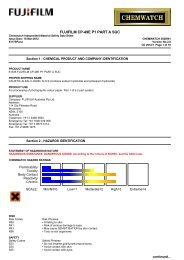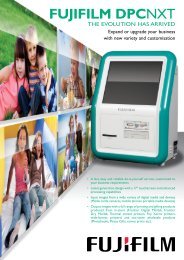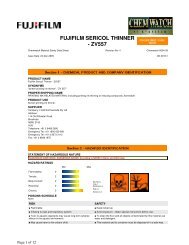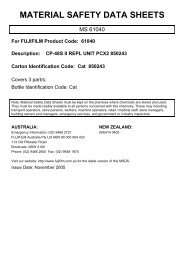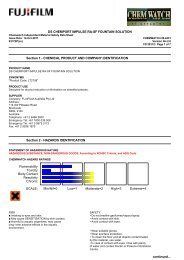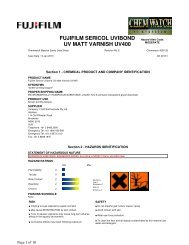Chemwatch Australian MSDS 31-8731 - FUJIFILM Australia
Chemwatch Australian MSDS 31-8731 - FUJIFILM Australia
Chemwatch Australian MSDS 31-8731 - FUJIFILM Australia
Create successful ePaper yourself
Turn your PDF publications into a flip-book with our unique Google optimized e-Paper software.
<strong>FUJIFILM</strong> CN-16Q NQ3-RS<br />
<strong>Chemwatch</strong> Independent Material Safety Data Sheet<br />
Issue Date: 7-May-2012 CHEMWATCH <strong>31</strong>-87<strong>31</strong><br />
X9<strong>31</strong>7SP(cs)<br />
Version No:2.0<br />
CD 2012/2 Page 1 of 8<br />
Section 1 - CHEMICAL PRODUCT AND COMPANY IDENTIFICATION<br />
PRODUCT NAME<br />
<strong>FUJIFILM</strong> CN-16Q NQ3-RS 850185<br />
PRODUCT CODE 391030<br />
PRODUCT USE<br />
■ Used according to manufacturer's directions.<br />
SUPPLIER<br />
Company: <strong>FUJIFILM</strong> <strong>Australia</strong> Pty Ltd<br />
Address:<br />
114 Old Pittwater Road<br />
Brookvale<br />
NSW, 2100<br />
<strong>Australia</strong><br />
Telephone: +61 2 9466 2600<br />
Emergency Tel: +61 1800 039 008<br />
Emergency Tel: +61 3 9573 <strong>31</strong>12<br />
Fax: +61 2 9938 1975<br />
Section 2 - HAZARDS IDENTIFICATION<br />
STATEMENT OF HAZARDOUS NATURE<br />
HAZARDOUS SUBSTANCE. NON-DANGEROUS GOODS. According to the Criteria of NOHSC, and the ADG Code.<br />
CHEMWATCH HAZARD RATINGS<br />
Flammability<br />
Toxicity<br />
Body Contact<br />
Reactivity<br />
Chronic<br />
SCALE: Min/Nil=0 Low=1 Moderate=2 High=3 Extreme=4<br />
RISK<br />
Risk Codes<br />
R20<br />
R33<br />
R36/37/38<br />
R68(3)<br />
SAFETY<br />
Safety Codes<br />
S23<br />
S24<br />
S25<br />
S36<br />
S37<br />
S39<br />
Risk Phrases<br />
• Harmful by inhalation.<br />
• Danger of cumulative effects.<br />
• Irritating to eyes, respiratory system and skin.<br />
• Possible risk of irreversible effects.<br />
Safety Phrases<br />
• Do not breathe gas/fumes/vapour/spray.<br />
• Avoid contact with skin.<br />
• Avoid contact with eyes.<br />
• Wear suitable protective clothing.<br />
• Wear suitable gloves.<br />
• Wear eye/face protection.<br />
continued...
<strong>FUJIFILM</strong> CN-16Q NQ3-RS<br />
<strong>Chemwatch</strong> Independent Material Safety Data Sheet<br />
Issue Date: 7-May-2012 CHEMWATCH <strong>31</strong>-87<strong>31</strong><br />
X9<strong>31</strong>7SP(cs)<br />
Version No:2.0<br />
CD 2012/2 Page 2 of 8<br />
Section 2 - HAZARDS IDENTIFICATION<br />
S51<br />
S09<br />
S40<br />
S07<br />
S13<br />
S26<br />
S46<br />
• Use only in well ventilated areas.<br />
• Keep container in a well ventilated place.<br />
• To clean the floor and all objects contaminated by this material, use water.<br />
• Keep container tightly closed.<br />
• Keep away from food, drink and animal feeding stuffs.<br />
• In case of contact with eyes, rinse with plenty of water and contact Doctor or<br />
Poisons Information Centre.<br />
• If swallowed, IMMEDIATELY contact Doctor or Poisons Information Centre. (show<br />
this container or label).<br />
Section 3 - COMPOSITION / INFORMATION ON INGREDIENTS<br />
NAME CAS RN %<br />
diammonium thiosulfate 7783-18-8 30-50<br />
sodium sulfite 7757-83-7 1-5<br />
EDTA disodium salt 139-33-3 0.1-1<br />
water 7732-18-5 40-60<br />
Section 4 - FIRST AID MEASURES<br />
SWALLOWED<br />
• If swallowed do NOT induce vomiting.<br />
• If vomiting occurs, lean patient forward or place on left side (head-down position, if possible) to maintain open airway and<br />
prevent aspiration.<br />
• Observe the patient carefully.<br />
• Never give liquid to a person showing signs of being sleepy or with reduced awareness; i.e. becoming unconscious.<br />
EYE<br />
■ If this product comes in contact with the eyes:<br />
• Wash out immediately with fresh running water.<br />
• Ensure complete irrigation of the eye by keeping eyelids apart and away from eye and moving the eyelids by occasionally lifting<br />
the upper and lower lids.<br />
• Seek medical attention without delay; if pain persists or recurs seek medical attention.<br />
• Removal of contact lenses after an eye injury should only be undertaken by skilled personnel.<br />
SKIN<br />
■ If skin or hair contact occurs:<br />
• Flush skin and hair with running water (and soap if available).<br />
• Seek medical attention in event of irritation.<br />
INHALED<br />
• If fumes or combustion products are inhaled remove from contaminated area.<br />
• Lay patient down. Keep warm and rested.<br />
• Prostheses such as false teeth, which may block airway, should be removed, where possible, prior to initiating first aid<br />
procedures.<br />
• Apply artificial respiration if not breathing, preferably with a demand valve resuscitator, bag-valve mask device, or pocket<br />
mask as trained. Perform CPR if necessary.<br />
• Inhalation of vapours or aerosols (mists, fumes) may cause lung oedema.<br />
• Corrosive substances may cause lung damage (e.g. lung oedema, fluid in the lungs).<br />
• As this reaction may be delayed up to 24 hours after exposure, affected individuals need complete rest (preferably in semirecumbent<br />
posture) and must be kept under medical observation even if no symptoms are (yet) manifested.<br />
• Before any such manifestation, the administration of a spray containing a dexamethasone derivative or beclomethasone derivative<br />
may be considered.<br />
NOTES TO PHYSICIAN<br />
■ Treat symptomatically.<br />
Depending on the degree of exposure, periodic medical examination is indicated. The symptoms of lung oedema often do not manifest<br />
until a few hours have passed and they are aggravated by physical effort.<br />
continued...
<strong>FUJIFILM</strong> CN-16Q NQ3-RS<br />
<strong>Chemwatch</strong> Independent Material Safety Data Sheet<br />
Issue Date: 7-May-2012 CHEMWATCH <strong>31</strong>-87<strong>31</strong><br />
X9<strong>31</strong>7SP(cs)<br />
Version No:2.0<br />
CD 2012/2 Page 3 of 8<br />
Section 5 - FIRE FIGHTING MEASURES<br />
EXTINGUISHING MEDIA<br />
• There is no restriction on the type of extinguisher which may be used.<br />
• Use extinguishing media suitable for surrounding area.<br />
FIRE FIGHTING<br />
• Alert Fire Brigade and tell them location and nature of hazard.<br />
• Wear breathing apparatus plus protective gloves in the event of a fire.<br />
• Prevent, by any means available, spillage from entering drains or water courses.<br />
• Use fire fighting procedures suitable for surrounding area.<br />
FIRE/EXPLOSION HAZARD<br />
• Non combustible.<br />
• Not considered a significant fire risk, however containers may burn.<br />
Decomposition may produce toxic fumes of: nitrogen oxides (NOx), sulfur oxides (SOx).<br />
May emit poisonous fumes.<br />
FIRE INCOMPATIBILITY<br />
■ None known.<br />
HAZCHEM<br />
None<br />
Section 6 - ACCIDENTAL RELEASE MEASURES<br />
MINOR SPILLS<br />
• Clean up all spills immediately.<br />
• Avoid breathing vapours and contact with skin and eyes.<br />
• Control personal contact with the substance, by using protective equipment.<br />
• Contain and absorb spill with sand, earth, inert material or vermiculite.<br />
MAJOR SPILLS<br />
■ Moderate hazard.<br />
• Clear area of personnel and move upwind.<br />
• Alert Fire Brigade and tell them location and nature of hazard.<br />
• Wear breathing apparatus plus protective gloves.<br />
• Prevent, by any means available, spillage from entering drains or water course.<br />
Personal Protective Equipment advice is contained in Section 8 of the <strong>MSDS</strong>.<br />
Section 7 - HANDLING AND STORAGE<br />
PROCEDURE FOR HANDLING<br />
• DO NOT allow clothing wet with material to stay in contact with skin.<br />
• Avoid all personal contact, including inhalation.<br />
• Wear protective clothing when risk of exposure occurs.<br />
• Use in a well-ventilated area.<br />
• Prevent concentration in hollows and sumps.<br />
SUITABLE CONTAINER<br />
• Polyethylene or polypropylene container.<br />
• Packing as recommended by manufacturer.<br />
• Check all containers are clearly labelled and free from leaks.<br />
STORAGE INCOMPATIBILITY<br />
■ For inorganic thiosulfates<br />
• Avoid storage with acids, metal nitrites, sodium nitrite, halogens and oxidizing agents.<br />
• Forms explosive product with potassium nitrate, sodium nitrate<br />
• Reacts with acids, forming sulfur dioxide<br />
• Incompatible with halogens, lead, silver and mercury salts. iodine.<br />
• Inorganic reducing agents react with oxidizing agents to generate heat and products that may be flammable, combustible, or<br />
otherwise reactive. Their reactions with oxidizing agents may be violent.<br />
• Incidents involving interaction of active oxidants and reducing agents, either by design or accident, are usually very<br />
continued...
<strong>FUJIFILM</strong> CN-16Q NQ3-RS<br />
<strong>Chemwatch</strong> Independent Material Safety Data Sheet<br />
Issue Date: 7-May-2012 CHEMWATCH <strong>31</strong>-87<strong>31</strong><br />
X9<strong>31</strong>7SP(cs)<br />
Version No:2.0<br />
CD 2012/2 Page 4 of 8<br />
Section 7 - HANDLING AND STORAGE<br />
energetic and examples of so-called redox reactions.<br />
Sulfites and hydrosulfites (dithionites) :<br />
• may react explosively with strong oxidising agents.<br />
• react with water or steam to produce corrosive acid solutions and sulfur oxide fumes - aqueous solutions are incompatible with<br />
oxidisers, strong acids, alkalis, ammonia, aliphatic amines, alkanolamines, alkylene oxides, amides, epichlorohydrin, organic<br />
anhydrides, isocyanates, nitromethane, vinyl acetate<br />
• aqueous solutions attack metals in presence of moisture<br />
• generate gaseous sulfur dioxide in contact with oxidising and nonoxidising acids.<br />
Sulfur dioxide:<br />
• reacts with water or steam forming sulfurous acid; reaction may be violent<br />
• reacts with acrolein, alcohols, aluminium powder, alkali metals, amines, bromine, pentafluoride, caustics, caesium, acetylene<br />
carbide, chlorates, chlorine trifluoride, chromium powder, copper or its alloy powders, diethylzinc, fluorine, lead dioxide,<br />
lithium acetylene carbide, metal powders, monolithium acetylide-ammonia, nitryl chloride, potassium acetylene carbide,<br />
potassium acetylide, potassium chlorate, rubidium carbide, silver azide, sodium, sodium acetylide, stannous oxide; reaction may<br />
be violent<br />
• decomposes above 60 deg. C releasing oxides of sulfur<br />
• Incompatible with alkalis, alkylene oxides, ammonia, aliphatic amines, alkanolamines, amides, organic anhydrides, caesium<br />
monoxide, epichlorohydrin, ferrous oxide, halogens, interhalogens, isocyanates, lithium nitrate, manganese, metal acetylides,<br />
metal oxides, perbromyl fluoride, red phosphorus, potassium azide, rubidium acetylide, sodium hydride, sulfuric acid.<br />
STORAGE REQUIREMENTS<br />
• Store in original containers.<br />
• Keep containers securely sealed.<br />
• Store in a cool, dry, well-ventilated area.<br />
• Store away from incompatible materials and foodstuff containers.<br />
Section 8 - EXPOSURE CONTROLS / PERSONAL PROTECTION<br />
EXPOSURE CONTROLS<br />
The following materials had no OELs on our records<br />
• diammonium thiosulfate: CAS:7783- 18- 8<br />
• sodium sulfite: CAS:7757- 83- 7 CAS:10102- 15- 5<br />
• EDTA disodium salt: CAS:139- 33- 3 CAS:69772- 70- 9<br />
• water: CAS:7732- 18- 5<br />
MATERIAL DATA<br />
DIAMMONIUM THIOSULFATE:<br />
EDTA DISODIUM SALT:<br />
■ It is the goal of the ACGIH (and other Agencies) to recommend TLVs (or their equivalent) for all substances for which there<br />
is evidence of health effects at airborne concentrations encountered in the workplace.<br />
At this time no TLV has been established, even though this material may produce adverse health effects (as evidenced in animal<br />
experiments or clinical experience).<br />
NOTE: The ACGIH occupational exposure standard for Particles Not Otherwise Specified (P.N.O.S) does NOT apply.<br />
<strong>FUJIFILM</strong> CN-16Q NQ3-RS:<br />
SODIUM SULFITE:<br />
■ Inorganic sulfites, bisulfites and metabisulfites (sodium, potassium and ammonium salts) liberate sulfur dioxide under<br />
certain conditions. Therefore the officially tabled exposure limits for these chemicals normally correspond to the yield of<br />
liberated sulfur dioxide.
<strong>FUJIFILM</strong> CN-16Q NQ3-RS<br />
<strong>Chemwatch</strong> Independent Material Safety Data Sheet<br />
Issue Date: 7-May-2012 CHEMWATCH <strong>31</strong>-87<strong>31</strong><br />
X9<strong>31</strong>7SP(cs)<br />
Version No:2.0<br />
CD 2012/2 Page 5 of 8<br />
Section 8 - EXPOSURE CONTROLS / PERSONAL PROTECTION<br />
RESPIRATOR<br />
•Particulate. (AS/NZS 1716 & 1715, EN 143:2000 & 149:2001, ANSI Z88 or national equivalent)<br />
EYE<br />
• Safety glasses with side shields<br />
• Chemical goggles.<br />
• Contact lenses may pose a special hazard; soft contact lenses may absorb and concentrate irritants. A written policy document,<br />
describing the wearing of lens or restrictions on use, should be created for each workplace or task. This should include a<br />
review of lens absorption and adsorption for the class of chemicals in use and an account of injury experience. Medical and<br />
first-aid personnel should be trained in their removal and suitable equipment should be readily available. In the event of<br />
chemical exposure, begin eye irrigation immediately and remove contact lens as soon as practicable. Lens should be removed at<br />
the first signs of eye redness or irritation - lens should be removed in a clean environment only after workers have washed<br />
hands thoroughly. [CDC NIOSH Current Intelligence Bulletin 59], [AS/NZS 1336 or national equivalent].<br />
HANDS/FEET<br />
• Wear chemical protective gloves, eg. PVC.<br />
• Wear safety footwear or safety gumboots, eg. Rubber.<br />
Suitability and durability of glove type is dependent on usage. Important factors in the selection of gloves include:<br />
• frequency and duration of contact,<br />
• chemical resistance of glove material,<br />
• glove thickness and<br />
• dexterity.<br />
OTHER<br />
• Overalls.<br />
• P.V.C. apron.<br />
• Barrier cream.<br />
• Skin cleansing cream.<br />
ENGINEERING CONTROLS<br />
■ Engineering controls are used to remove a hazard or place a barrier between the worker and the hazard. Well-designed<br />
engineering controls can be highly effective in protecting workers and will typically be independent of worker interactions to<br />
provide this high level of protection.<br />
The basic types of engineering controls are:<br />
Process controls which involve changing the way a job activity or process is done to reduce the risk.<br />
Enclosure and/or isolation of emission source which keeps a selected hazard "physically" away from the worker and ventilation<br />
that strategically "adds" and "removes" air in the work environment.<br />
Section 9 - PHYSICAL AND CHEMICAL PROPERTIES<br />
APPEARANCE<br />
Colourless liquid with a slight ammoniacal odour; mixes with water.<br />
PHYSICAL PROPERTIES<br />
Liquid.<br />
Mixes with water.<br />
State Liquid Molecular Weight Not Applicable<br />
Melting Range (°C) Not Available Viscosity Not Available<br />
Boiling Range (°C) Not Available Solubility in water (g/L) Miscible<br />
Flash Point (°C) Not Applicable pH (1% solution) Not Available<br />
Decomposition Temp (°C) Not Available pH (as supplied) 8.1<br />
Autoignition Temp (°C) Not Applicable Vapour Pressure (kPa) Not Available<br />
Upper Explosive Limit (%) Not Applicable Specific Gravity (water=1) 1.275<br />
Lower Explosive Limit (%) Not Applicable Relative Vapour Density Not Available<br />
(air=1)<br />
Volatile Component (%vol) Not Available Evaporation Rate Not Available<br />
continued...
<strong>FUJIFILM</strong> CN-16Q NQ3-RS<br />
<strong>Chemwatch</strong> Independent Material Safety Data Sheet<br />
Issue Date: 7-May-2012 CHEMWATCH <strong>31</strong>-87<strong>31</strong><br />
X9<strong>31</strong>7SP(cs)<br />
Version No:2.0<br />
CD 2012/2 Page 6 of 8<br />
Section 10 - STABILITY AND REACTIVITY<br />
CONDITIONS CONTRIBUTING TO INSTABILITY<br />
• Presence of incompatible materials.<br />
• Product is considered stable.<br />
• Hazardous polymerisation will not occur.<br />
For incompatible materials - refer to Section 7 - Handling and Storage.<br />
Section 11 - TOXICOLOGICAL INFORMATION<br />
POTENTIAL HEALTH EFFECTS<br />
ACUTE HEALTH EFFECTS<br />
SWALLOWED<br />
■ Accidental ingestion of the material may be damaging to the health of the individual.<br />
Thiosulfate salts are poorly absorbed and stimulate the emptying of thebowel.<br />
Large doses of ammonia or injected ammonium salts may produce diarrhoea and may be sufficiently absorbed to produce increased<br />
production of urine and systemic poisoning. Symptoms include weakening of facial muscle, tremor, anxiety, reduced muscle and limb<br />
control.<br />
EYE<br />
■ This material can cause eye irritation and damage in some persons.<br />
SKIN<br />
■ This material can cause inflammation of the skin oncontact in some persons.<br />
Entry into the blood-stream, through, for example, cuts, abrasions or lesions, may produce systemic injury with harmful effects.<br />
Examine the skin prior to the use of the material and ensure that any external damage is suitably protected.<br />
INHALED<br />
■ Inhalation of vapours or aerosols (mists, fumes), generated by the material during the course of normal handling, may be<br />
harmful.<br />
The material can cause respiratory irritation in some persons. The body's response to such irritation can cause further lung<br />
damage.<br />
CHRONIC HEALTH EFFECTS<br />
■ Substance accumulation, in the human body, is likely and may cause some concern following repeated or long-term occupational<br />
exposure.<br />
Strong evidence exists that this substance may cause irreversible mutations (though not lethal) even following a single exposure.<br />
Laboratory (in vitro) and animal studies show, exposure to the material may result in a possible risk of irreversible effects,<br />
with the possibility of producing mutation.<br />
Sulfites and bisulfites can cause narrowing of the airways, stomach upset, flushing, low blood pressure, tingling sensation,<br />
itchy wheal, swelling and shock, and asthmatics are especially prone. They induce allergic-like reactions which can occur on<br />
first contact with the material.<br />
TOXICITY AND IRRITATION<br />
■ No significant acute toxicological data identified in literature search.<br />
Contact allergies quickly manifest themselves as contact eczema, more rarely as urticaria or Quincke's oedema. The pathogenesis<br />
of contact eczema involves a cell-mediated (T lymphocytes) immune reaction of the delayed type. Other allergic skin reactions,<br />
e.g. contact urticaria, involve antibody-mediated immune reactions. The significance of the contact allergen is not simply<br />
determined by its sensitisation potential: the distribution of the substance and the opportunities for contact with it are<br />
equally important. A weakly sensitising substance which is widely distributed can be a more important allergen than one with<br />
stronger sensitising potential with which few individuals come into contact. From a clinical point of view, substances are<br />
noteworthy if they produce an allergic test reaction in more than 1% of the persons tested.<br />
Asthma-like symptoms may continue for months or even years after exposure to the material ceases. This may be due to a nonallergenic<br />
condition known as reactive airways dysfunction syndrome (RADS) which can occur following exposure to high levels of<br />
highly irritating compound.<br />
CARCINOGEN<br />
Sulfites International Agency for Research on Cancer Group 3<br />
(IARC) - Agents Reviewed by the IARC<br />
Monographs<br />
continued...
<strong>FUJIFILM</strong> CN-16Q NQ3-RS<br />
<strong>Chemwatch</strong> Independent Material Safety Data Sheet<br />
Issue Date: 7-May-2012 CHEMWATCH <strong>31</strong>-87<strong>31</strong><br />
X9<strong>31</strong>7SP(cs)<br />
Version No:2.0<br />
CD 2012/2 Page 7 of 8<br />
No data<br />
Section 12 - ECOLOGICAL INFORMATION<br />
Ecotoxicity<br />
Ingredient Persistence: Persistence: Air Bioaccumulation Mobility<br />
Water/Soil<br />
diammonium thiosulfate No Data No Data LOW<br />
Available<br />
Available<br />
sodium sulfite No Data No Data<br />
Available<br />
Available<br />
EDTA disodium salt LOW No Data LOW MED<br />
Available<br />
Section 13 - DISPOSAL CONSIDERATIONS<br />
• Containers may still present a chemical hazard/ danger when empty.<br />
• Return to supplier for reuse/ recycling if possible.<br />
Otherwise:<br />
• If container can not be cleaned sufficiently well to ensure that residuals do not remain or if the container cannot be used to<br />
store the same product, then puncture containers, to prevent re-use, and bury at an authorised landfill.<br />
• Where possible retain label warnings and <strong>MSDS</strong> and observe all notices pertaining to the product.<br />
Legislation addressing waste disposal requirements may differ by country, state and/ or territory. Each user must refer to laws<br />
operating in their area.<br />
A Hierarchy of Controls seems to be common - the user should investigate:<br />
• Reduction.<br />
• DO NOT allow wash water from cleaning or process equipment to enter drains.<br />
• It may be necessary to collect all wash water for treatment before disposal.<br />
• In all cases disposal to sewer may be subject to local laws and regulations and these should be considered first.<br />
• Where in doubt contact the responsible authority.<br />
• Recycle wherever possible.<br />
• Consult manufacturer for recycling options or consult local or regional waste management authority for disposal if no suitable<br />
treatment or disposal facility can be identified.<br />
• Dispose of by: burial in a land-fill specifically licenced to accept chemical and / or pharmaceutical wastes or incineration in<br />
a licenced apparatus (after admixture with suitable combustible material).<br />
• Decontaminate empty containers. Observe all label safeguards until containers are cleaned and destroyed.<br />
Section 14 - TRANSPORTATION INFORMATION<br />
HAZCHEM:<br />
None (ADG7)<br />
■ Air transport may be forbidden if this material is flammable, corrosive or toxic gases may be released under normal conditions<br />
of transport.<br />
NOT REGULATED FOR TRANSPORT OF DANGEROUS GOODS: ADG7, UN, IATA, IMDG<br />
Section 15 - REGULATORY INFORMATION<br />
POISONS SCHEDULE None<br />
REGULATIONS<br />
Fujifilm CN-16Q NQ3-Rs (CAS: ) is found on the following regulatory lists;<br />
"International Agency for Research on Cancer (IARC) - Agents Reviewed by the IARC Monographs"<br />
Regulations for ingredients<br />
diammonium thiosulfate (CAS: 7783-18-8) is found on the following regulatory lists;<br />
"<strong>Australia</strong> Hazardous Substances","<strong>Australia</strong> Inventory of Chemical Substances (AICS)","<strong>Australia</strong> National Pollutant Inventory",<br />
"OECD List of High Production Volume (HPV) Chemicals"<br />
Witco BWT 2010 (CAS: 7757-83-7,10102-15-5) is found on the following regulatory lists;<br />
"<strong>Australia</strong> - Victoria Drugs, Poisons and Controlled Substances (Precursor Chemicals) Regs 2007 - Schedule 1 - Precursor Chemicals<br />
continued...
<strong>FUJIFILM</strong> CN-16Q NQ3-RS<br />
<strong>Chemwatch</strong> Independent Material Safety Data Sheet<br />
Issue Date: 7-May-2012 CHEMWATCH <strong>31</strong>-87<strong>31</strong><br />
X9<strong>31</strong>7SP(cs)<br />
Version No:2.0<br />
CD 2012/2 Page 8 of 8<br />
Section 15 - REGULATORY INFORMATION<br />
and Quantities","<strong>Australia</strong> Inventory of Chemical Substances (AICS)","<strong>Australia</strong> National Pollutant Inventory","<strong>Australia</strong> Standard<br />
for the Uniform Scheduling of Medicines and Poisons (SUSMP) - Appendix F (Part 3)","International Agency for Research on Cancer<br />
(IARC) - Agents Reviewed by the IARC Monographs","OECD List of High Production Volume (HPV) Chemicals"<br />
EDTA disodium salt (CAS: 139-33-3,69772-70-9) is found on the following regulatory lists;<br />
"<strong>Australia</strong> Inventory of Chemical Substances (AICS)","OECD List of High Production Volume (HPV) Chemicals"<br />
water (CAS: 7732-18-5) is found on the following regulatory lists;<br />
"<strong>Australia</strong> Inventory of Chemical Substances (AICS)","International Fragrance Association (IFRA) Survey: Transparency List","OECD<br />
List of High Production Volume (HPV) Chemicals","OSPAR National List of Candidates for Substitution – Norway"<br />
Section 16 - OTHER INFORMATION<br />
Denmark Advisory list for selfclassification of dangerous substances<br />
Substance CAS Suggested codes<br />
EDTA disodium salt 139- 33- 3 Xn; R22<br />
INGREDIENTS WITH MULTIPLE CAS NUMBERS<br />
Ingredient Name<br />
CAS<br />
sodium sulfite 7757- 83- 7, 10102- 15- 5<br />
EDTA disodium salt 139- 33- 3, 69772- 70- 9<br />
■ Classification of the preparation and its individual components has drawn on official and authoritative sources as well as<br />
independent review by the <strong>Chemwatch</strong> Classification committee using available literature references.<br />
A list of reference resources used to assist the committee may be found at:<br />
www.chemwatch.net/references.<br />
■ The (M)SDS is a Hazard Communication tool and should be used to assist in the Risk Assessment. Many factors determine whether<br />
the reported Hazards are Risks in the workplace or other settings.<br />
This document is copyright. Apart from any fair dealing for the purposes of private study, research, review or<br />
criticism, as permitted under the Copyright Act, no part may be reproduced by any process without written<br />
permission from CHEMWATCH. TEL (+61 3) 9572 4700.<br />
Issue Date: 7-May-2012<br />
Print Date: 7-May-2012<br />
This is the end of the <strong>MSDS</strong>.


